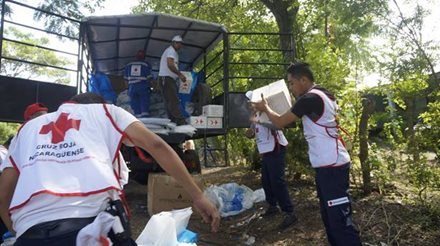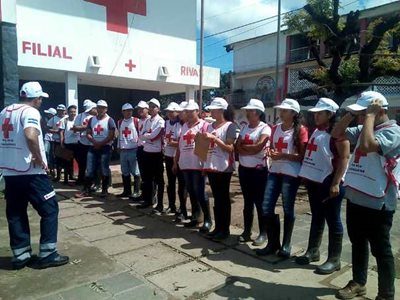In the hours leading up to Tropical Storm Nate, the Nicaraguan Red Cross was on high alert. They had activated their Emergency Operations Centre and were closely monitoring the impending storm.
Through the support of a Canadian Red Cross initiative called Capacity Building for Emergency Response in the Americas (CERA), the National Society’s disaster preparedness and response system has been strengthened, allowing the Nicaraguan Red Cross to respond effectively to storms and other emergencies.
The predictions suggested that Nate would affect the northern Atlantic region of Nicaragua, but unexpectedly, it hit the southern Pacific part of the country hardest.

Hurricane Nate caused 16 deaths and affected nearly 30,000 people in over 600 communities. Fortunately, the Nicaraguan Red Cross had activated the regional response system before the storm, by tapping into available support. This meant the National Society was able to begin relief activities for 200 families within 72 hours, a critical early period in the aftermath of an emergency.
Immediately after the storm hit, the Nicaraguan Red Cross deployed a team of first responders, some trained through the CERA initiative, to help local authorities with the evacuation process.
According to first responder Celena Alejandra Solís, “There were newborn babies as young as one month old and families who didn’t want to leave their homes because they were afraid of losing their possessions. However, after an hour they were forced to leave because the water had risen to waist-level, so we had to get them out. We helped evacuate these people, as well as their animals, because they didn’t want to leave them behind.”
Through the support of the CERA initiative, Celena had been trained as a National Intervention Team (NIT) member in 2015 – which means she is trained to respond to disasters and emergencies at a national level - and her expertise was put to good use in helping people reach safety.
 When it comes to emergencies like this, national and regional preparedness response systems are linked - and they are both key to saving lives. The Nicaraguan Red Cross anticipated a potential risk and took the necessary measures to mobilize staff and volunteers. Disaster responses like this always start at a national level, but when the needs are too big fora National Red Cross Society there is regional and global resources that are available. Following Hurricane Nate, the regional system quickly acted to provide them with the financial resources and technical expertise for greater impact.
When it comes to emergencies like this, national and regional preparedness response systems are linked - and they are both key to saving lives. The Nicaraguan Red Cross anticipated a potential risk and took the necessary measures to mobilize staff and volunteers. Disaster responses like this always start at a national level, but when the needs are too big fora National Red Cross Society there is regional and global resources that are available. Following Hurricane Nate, the regional system quickly acted to provide them with the financial resources and technical expertise for greater impact.Thanks to support from the Government of Canada, the Canadian Red Cross has been able provide assistance for National Societies to be ready and trained to respond to disasters and emergencies at both a national and regional level.
To continue the learning and improvement process, the CERA initiative deployed an evaluation team to assess the Nicaraguan Red Cross response to Tropical Storm Nate in real time. The National Society will build on successes and lessons observed, allowing them to strengthen their response to future emergencies.

